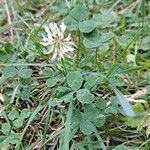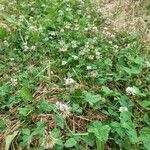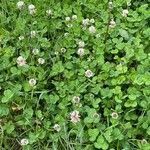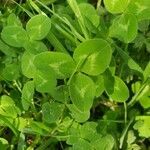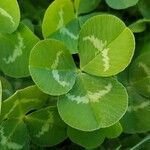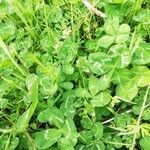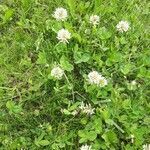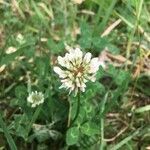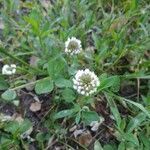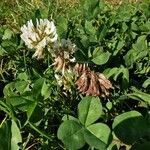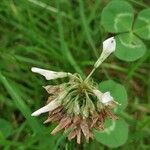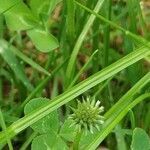Perennial; stems glabrous, creeping, rooting at nodes. Lvs ± glabrous; petioles up to 140-(200) mm long; leaflets obovate to elliptic or suborbicular, obtuse to obcordate, cuneate at base, finely serrate, often with light or dark markings, c. 5-25 mm long; lateral veins thin or somewhat thickened and ± straight to leaflet margin; petiolules up to c. 1 mm long, ± equal; stipules oblong, acuminate. Infls axillary, racemose, globose, pedunculate, > lvs; fls numerous; pedicel up to 5 mm long; bracts subtending fls free. Calyx ± glabrous, 10-veined, not inflated at fruiting; throat open, glabrous; calyx teeth somewhat unequal (2 upper longer), < corolla, triangular to narrowly triangular, < tube, erect at fruiting; sinuses acute. Corolla usually white, occasionally pink to reddish, persistent, 8-12 mm long. Pod glabrous, straight, > calyx, 4-5 mm long, 2-5-seeded; seeds c. 1 mm diam.
Perennial herbs, stoloniferous, glabrous to glabrescent. Stems 10-30 cm, prostrate, rooting at nodes. Leaves long petiolate, palmately 3-foliolate; stipules ovate-lanceolate, membranous, with veins green or red, sheathing at base, apex subulate; petiolule 1-1.5 mm; leaflets obovate to ovate, 6-20(-40) × 8-16(-25) mm, lateral veins 13 pairs, prominent on both surfaces, base cuneate, apex emarginate to broadly rounded. Flowers 20-50(-80), in terminal, globose umbels, 1.5-4 cm; peduncle equal to or longer than petiole; involucre absent; bracts lanceolate-ovate, membranous; pedicels 2-5 mm, reflexed after anthesis. Calyx 3-5 mm, veins 6-10; teeth shorter than tube. Corolla white, rarely pink-tinged, 5-12 mm, fragrant; standard elliptic, ca. 2 × wings and keel. Ovary sessile; ovules 3 or 4. Legume linear-oblong. Seeds 2-4, ovoid to reniform. Fl. and fr. May-Oct.
Perennial; stems creeping, sending up long-petioled lvs and long-peduncled heads; stipules connate beyond the level of adnation to the petiole to form a pale, tubular-amplexicaul sheath, but the tips separate; lfls broadly elliptic to obovate, rounded to retuse at the summit, 1–2 cm; fls 7–11 mm, distinctly pedicellate; cal glabrous, the tube 1.8–3 mm, the nerves leading to the acute sinuses sharply defined and ending in a purple spot; cal-lobes narrowly triangular, acuminate, unequal, the longest about equaling the tube; cor white or tinged with pink, the standard elliptic-obovate, rounded at the tip, exceeding the obtuse wings; 2n=32 (64). Native of Eurasia, commonly planted and escaped in lawns and roadsides throughout most of temperate N. Amer. All summer.
Creeping, perennial herb, 0.1-0.3 m long; stems rhizomatous, prostrate, rooting at nodes. Leaves long-petioled. Leaflets 6-25 x 10-15 mm, broadly obovate to orbicular, apex emarginate; margin sharply serrulate; parallel lateral veins forked towards margins. Stipules broad at base, upper part subulate, scarious with reddish or green nerves. Inflorescences 15-35 mm in diam., umbellate, 20-many-flowered; peduncles much longer than petioles of subtending leaves. Flowers white, yellow or pink, pedicels much longer than calyx; corolla twice as long as calyx. Petals: standard ovate-lanceolate, rounded at apex. Flowering time Oct.-Dec. Pod linear-oblong, 3-or 4-seeded, constricted between seeds.
A creeping or erect herb. It keeps growing from year to year. It grows 20 cm high. The stems are creeping and hairless and root at the nodes. The leaves have 3 leaflets. The leaflets can be oval or heart shaped. They have a dent in at the ends. They are hairless. They are on long stalks and usually have a white band. The flowers are white and in a round head. It is on a stalk that is longer than the leaves. The pods are narrowly oblong. They are 4-5 mm long. There are 2-5 seeds.
Perennial herb, up to 300 mm high. Stems procumbent. Leaves long-petioled; leaflets < twice as long as wide, cuneate-obovate, lateral nerves straight, pale; stipules small, obovate-lanceolate, with short, subulate points. Flowers: with slender pedicels, reflexed after flowering; calyx 3-5 mm long; corolla white to pinkish; Mar.-Dec. Pod linear-oblong; constricted between seeds, 3-or 4-seeded.
Corolla white or whitish or pinkish, ± twice as long as the calyx; standard oblong; wings subequalling the claw, the auricles short and broad; keel slightly shorter than the wings.
Glabrate perennial herb, rooting at the nodes. Leaves trifoliolate, the leaflets obcordate, 8-15 mm long, 10-20 mm wide, the venation conspicuous, parallel,
Leaves long-petioled; leaflets cuneate-obovate, the lateral nerves straight, pale; stipules small, obovate-lanceolate, with short, subulate points.
Calyx glabrous; tube campanulate, 10-nerved; teeth triangular-lanceolate, subulate, pale-margined, the two upper longer.
Inflorescence globose; peduncle very long, erect; bracts small, ovate-oblong, acuminate.
Flowers with pedicels slender, reflexed after flowering.
Stems creeping and rooting at the nodes.
Pod linear-oblong, 3–4 seeded.
Perennial herb, glabrous.
Seeds ovoid, pale brown.
